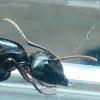OK, so I went scrounging around acorns looking for Temnothorax, since they'd flown the past few days, thinking maybe I could find a few founding queens, and got more than I bargained for...
Species 1:
1. Location (on a map) of collection: McDonald, OH
2. Date of collection: 4-5-17
3. Habitat of collection: Clearing in small lightly wooded area
4. Length (from head to gaster): Queen: Approx. 5mm, Workers 3-4mm
5. Color, hue, pattern and texture: Rough-looking texture on head and thorax, fuzzy-looking gaster. Head is dark brown, body is brown, gaster is dark brown, two petiole nodes. Pupa are "naked".
6. Distinguishing characteristics: Body almost has a kind of zigzag up and down profile
7. Distinguishing behavior: Nothing of note
8. Nest description: Old acorns in leaf litter or in the clearing.
I found 5 different colonies of various sizes, the smallest was only queen and small brood, but the larger ones had several workers and pupa in the brood.


Sorry, I know the pics aren't great, but the ants were small and this was the best I could do.
Species 2:
1. Location (on a map) of collection: McDonald, OH
2. Date of collection: 4-5-17
3. Habitat of collection: Clearing in small lightly wooded area
4. Length (from head to gaster): 5mm
5. Color, hue, pattern and texture: Smooth texture, all black.
6. Distinguishing characteristics: Gaster is shiny enough to reflect light a bit, and is wider than it is high, like a slightly flattened oval.
7. Distinguishing behavior: Very calm, even under the light. Just stands guard over eggs and doesn't move much.
8. Nest description: Old acorn in light leaf litter with about a dozen eggs.




Species 3:
1. Location (on a map) of collection: McDonald, OH
2. Date of collection: 4-5-17
3. Habitat of collection: Clearing in small lightly wooded area
4. Length (from head to gaster): Approx. 8mm
5. Color, hue, pattern and texture: Dark brown with slightly lighter legs and underside. Smooth texture.
6. Distinguishing characteristics: Gaster has smooth, "plated" looking segments
7. Distinguishing behavior: None of note
8. Nest description: N/A, was found wandering alone under leaf litter.


Species 4:
1. Location (on a map) of collection: McDonald, OH
2. Date of collection: 4-5-17
3. Habitat of collection: Clearing in small lightly wooded area
4. Length (from head to gaster): One slightly bigger one 4mm, the rest 3mm
5. Color, hue, pattern and texture: Dark brown, smooth. Very long and skinny, barely look like ants.
6. Distinguishing characteristics: They don't seem to be able to walk on smooth surfaces well.
7. Distinguishing behavior: Like to hang out on the damp cotton, also pulled all brood there. I'm thinking they like the wetness and the gripping surface.
8. Nest description: Very rotten acorn, was almost dirt-like inside. Very small colony, only found these few workers (and maybe queen?) and some brood. One is slightly bigger than the others, with slightly thicker thorax and gaster. Not sure if she's the queen or not. Would seem odd for there to not be one though, unless I somehow missed her.



If you make any IDs, please give the species number please! Otherwise I'll get confused. Also, this thread is cross-posted across two forums, I figured I'd have better odds of getting an ID for everything that way. Any help will be greatly appreciated!


















